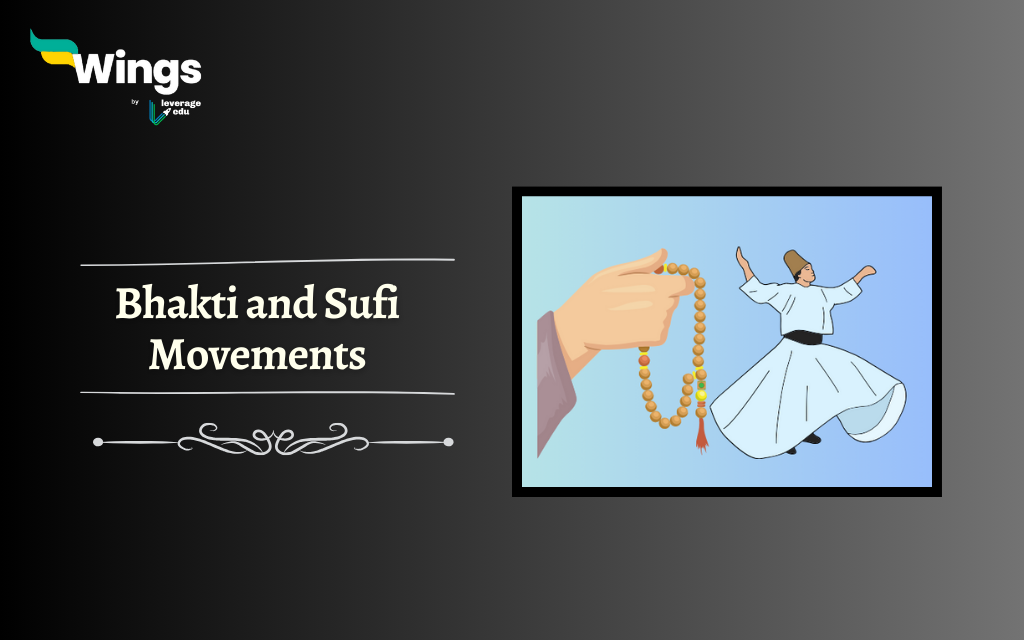The Bhakti and Sufi movements were two important spiritual movements in India that started many years ago, between the 8th and 18th centuries. Even though Bhakti came from the Hindu tradition and Sufism from the Islamic tradition, both focused on love and devotion to God. They did not believe in complicated rituals or strict rules and wanted people to treat each other equally, no matter their caste or religion. The Bhakti movement spread mostly in South and North India, while the Sufi movement came from the Islamic world and grew in different parts of India.
In this blog, we will learn about where these movements started, what they taught, who their main saints were, and how they were similar and different. This will help us understand how both movements helped bring people together and made Indian society more spiritual and united.
Contents
What is the Bhakti and Sufi Movement?
Both movements had a lasting impact on the golden chapters of Indian history. Let’s together know more about them-
Bhakti Movement:
The Bhakti movement originated in South India around the 8th century and later spread to other parts of the country. It was a response to the rigidity of the caste system and the dominance of Brahminical rituals in Hinduism. Bhakti saints sought to establish a direct and personal relationship with the divine. It emphasised devotion to deities such as Rama, Krishna, and Shiva.
Must Read – Bhakti Movement: Origin, Causes, Impact & More
Sufi Movement:
The Sufi movement originated in the Islamic world during the 7th century and later spread to the Indian subcontinent. It was deeply influenced by the mystical traditions of Islam and sought a direct experiential connection with God. Sufism emphasized inner spirituality rather than outward rituals. Sufis engaged in practices such as meditation, chanting, and dhikr (remembrance of God) to attain spiritual union with the divine. They followed the guidance of spiritual masters or Sufi saints who acted as their mentors and guides on the path of spiritual realization.
Must Read – Sufi Movement: Features, Stages, Important Silsilas and Impact
What is the difference between the Bhakti and Sufi movements?
The differences between the two movements are listed in the following table –
| Feature | Bhakti Movement (Hinduism) | Sufi Movement (Islam) |
| Origins | 8th century in India | 7th century in the Middle East spread to India in the 12th century |
| Central theme | Personal devotion and love for God (Ishta Deva) | Mystical union and oneness with God |
| Emphasis | Bhakti (devotion), emotional connection, surrender | Fana (annihilation of self), intellectual journey, spiritual transformation |
| Deity/God | Emphasis on specific deities (Vishnu, Shiva, Krishna, etc.) | Monotheistic belief in a single, formless God |
| Religious Texts | Bhakti poems, hymns, and vernacular translations of scriptures | Sufi poetry, qawwalis, mystic texts, etc |
| Practices | Singing bhajan (devotional songs), performing darshan (seeing the deity), pilgrimages, etc | Dhikr (remembrance of God), Sama (spiritual music sessions), murshid-disciple relationship, etc |
| Social Impact | Challenged caste hierarchy, promoted bhakti as accessible to all | Criticized religious dogmas and emphasised social justice and tolerance. |
| Famous figures | Mirabai, Chaitanya Mahaprabhu, Tulsidas, Kabir, Guru Nanak, etc | Rumi, Shams Tabrizi, Jalaluddin Rumi, Moinuddin Chishti |
| Legacy | Deeply influenced by Indian culture, literature, music, and spirituality | Contributed to interfaith dialogue and mysticism in India and beyond |
Also Read – What is the Difference Between Nayanars and Alvars?
What were the similarities between the movements?
The influence of the movement was widespread, and they had many similarities too-
- Role of music and dance: Both movements used music and dance as forms of devotion and spiritual expression.
- Rejection of rituals & formal religion: Both the Bhakti and Sufi traditions often questioned rigid ritualistic practices and formal religious structures, highlighting the importance of personal devotion and direct spiritual experience.
- Social reform and inclusivity: Both movements promoted social justice and challenged hierarchical structures in their respective societies.
In conclusion, the Bhakti and Sufi movements played an instrumental role in transforming the religious and cultural traditions prevailing in the country. They provided a path towards a deeper understanding of oneself and the divine through their emphasis on love, devotion, and spirituality. These movements continue to inspire people of diverse backgrounds.
Impact of these movements on Society
The Bhakti and Sufi movements had a deep impact on Indian society:
- Helped bridge the gap between different communities (Hindus and Muslims).
- Gave voice to the common people through local language and art.
- Reduced the importance of caste and social discrimination.
- Created a sense of spiritual unity and love among people.
- Inspired future social reformers and freedom fighters.
FAQs
The Bhakti movement is rooted in the Hindu tradition and focuses on devotion to personal gods like Krishna, Rama, or Shiva. The Sufi movement comes from Islam and emphasizes devotion to a formless God (Allah) through love and inner purification.
No, both Bhakti and Sufi saints strongly opposed caste discrimination and social divisions. They preached equality, saying that all humans are equal in the eyes of God.
They used local languages, simple words, poetry, and songs (like bhajans and qawwalis) to reach common people. This made their teachings easy to understand and widely accepted.
Relevant Blogs
| Essay on Nelson Mandela | Essay on Abraham Lincoln |
| Essay on Rani Lakshmi Bai | Essay on Bhagat Singh |
| Difference Between Qualitative Analysis and Quantitative Analysis | Essay on My Grandmother |
That’s all about the Bhakti and Sufi Movement! If you want to know more about topics like this, then visit our general knowledge page! Alternatively, you can also read our blog on general knowledge for competitive exams!
 One app for all your study abroad needs
One app for all your study abroad needs














